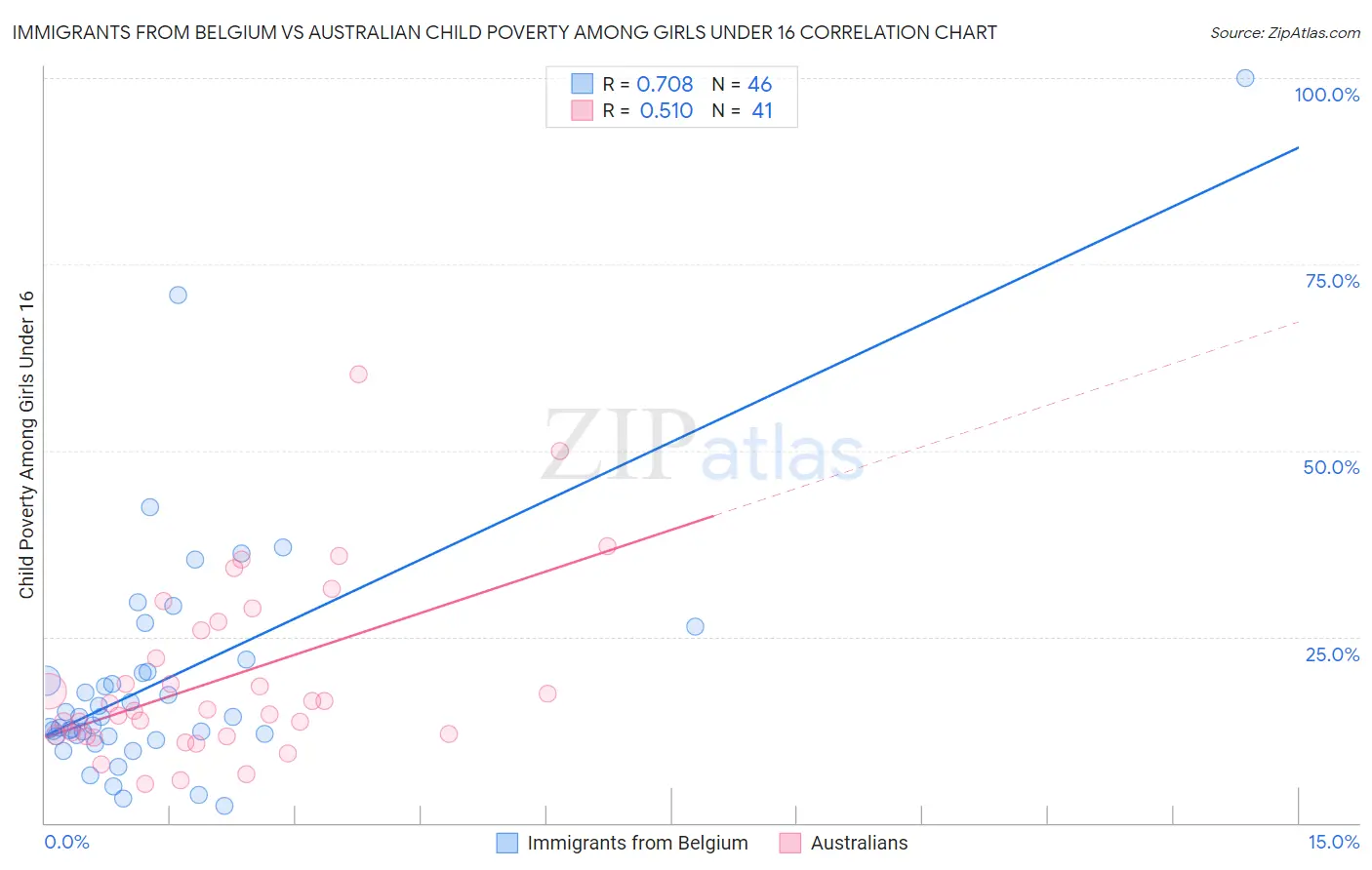Immigrants from Belgium vs Australian Child Poverty Among Girls Under 16
COMPARE
Immigrants from Belgium
Australian
Child Poverty Among Girls Under 16
Child Poverty Among Girls Under 16 Comparison
Immigrants from Belgium
Australians
14.5%
CHILD POVERTY AMONG GIRLS UNDER 16
98.5/ 100
METRIC RATING
66th/ 347
METRIC RANK
14.8%
CHILD POVERTY AMONG GIRLS UNDER 16
97.2/ 100
METRIC RATING
86th/ 347
METRIC RANK
Immigrants from Belgium vs Australian Child Poverty Among Girls Under 16 Correlation Chart
The statistical analysis conducted on geographies consisting of 145,025,757 people shows a strong positive correlation between the proportion of Immigrants from Belgium and poverty level among girls under the age of 16 in the United States with a correlation coefficient (R) of 0.708 and weighted average of 14.5%. Similarly, the statistical analysis conducted on geographies consisting of 221,150,197 people shows a substantial positive correlation between the proportion of Australians and poverty level among girls under the age of 16 in the United States with a correlation coefficient (R) of 0.510 and weighted average of 14.8%, a difference of 2.2%.

Child Poverty Among Girls Under 16 Correlation Summary
| Measurement | Immigrants from Belgium | Australian |
| Minimum | 2.3% | 5.3% |
| Maximum | 100.0% | 60.2% |
| Range | 97.7% | 54.9% |
| Mean | 19.4% | 19.5% |
| Median | 14.3% | 15.3% |
| Interquartile 25% (IQ1) | 11.6% | 11.7% |
| Interquartile 75% (IQ3) | 20.4% | 26.4% |
| Interquartile Range (IQR) | 8.8% | 14.7% |
| Standard Deviation (Sample) | 17.1% | 11.9% |
| Standard Deviation (Population) | 17.0% | 11.7% |
Demographics Similar to Immigrants from Belgium and Australians by Child Poverty Among Girls Under 16
In terms of child poverty among girls under 16, the demographic groups most similar to Immigrants from Belgium are Laotian (14.5%, a difference of 0.41%), Immigrants from Argentina (14.6%, a difference of 0.55%), Immigrants from Poland (14.6%, a difference of 0.71%), European (14.6%, a difference of 0.83%), and Slovene (14.6%, a difference of 0.87%). Similarly, the demographic groups most similar to Australians are Swiss (14.8%, a difference of 0.040%), Soviet Union (14.8%, a difference of 0.15%), Immigrants from Italy (14.8%, a difference of 0.23%), Macedonian (14.7%, a difference of 0.48%), and Ukrainian (14.7%, a difference of 0.72%).
| Demographics | Rating | Rank | Child Poverty Among Girls Under 16 |
| Immigrants | Belgium | 98.5 /100 | #66 | Exceptional 14.5% |
| Laotians | 98.4 /100 | #67 | Exceptional 14.5% |
| Immigrants | Argentina | 98.3 /100 | #68 | Exceptional 14.6% |
| Immigrants | Poland | 98.2 /100 | #69 | Exceptional 14.6% |
| Europeans | 98.1 /100 | #70 | Exceptional 14.6% |
| Slovenes | 98.1 /100 | #71 | Exceptional 14.6% |
| Immigrants | Netherlands | 98.1 /100 | #72 | Exceptional 14.6% |
| Immigrants | Austria | 98.0 /100 | #73 | Exceptional 14.6% |
| Taiwanese | 98.0 /100 | #74 | Exceptional 14.6% |
| Immigrants | Eastern Europe | 98.0 /100 | #75 | Exceptional 14.6% |
| Immigrants | Russia | 97.9 /100 | #76 | Exceptional 14.7% |
| Tlingit-Haida | 97.9 /100 | #77 | Exceptional 14.7% |
| Argentineans | 97.9 /100 | #78 | Exceptional 14.7% |
| Immigrants | Turkey | 97.9 /100 | #79 | Exceptional 14.7% |
| Egyptians | 97.9 /100 | #80 | Exceptional 14.7% |
| Ukrainians | 97.7 /100 | #81 | Exceptional 14.7% |
| Macedonians | 97.6 /100 | #82 | Exceptional 14.7% |
| Immigrants | Italy | 97.4 /100 | #83 | Exceptional 14.8% |
| Soviet Union | 97.3 /100 | #84 | Exceptional 14.8% |
| Swiss | 97.2 /100 | #85 | Exceptional 14.8% |
| Australians | 97.2 /100 | #86 | Exceptional 14.8% |